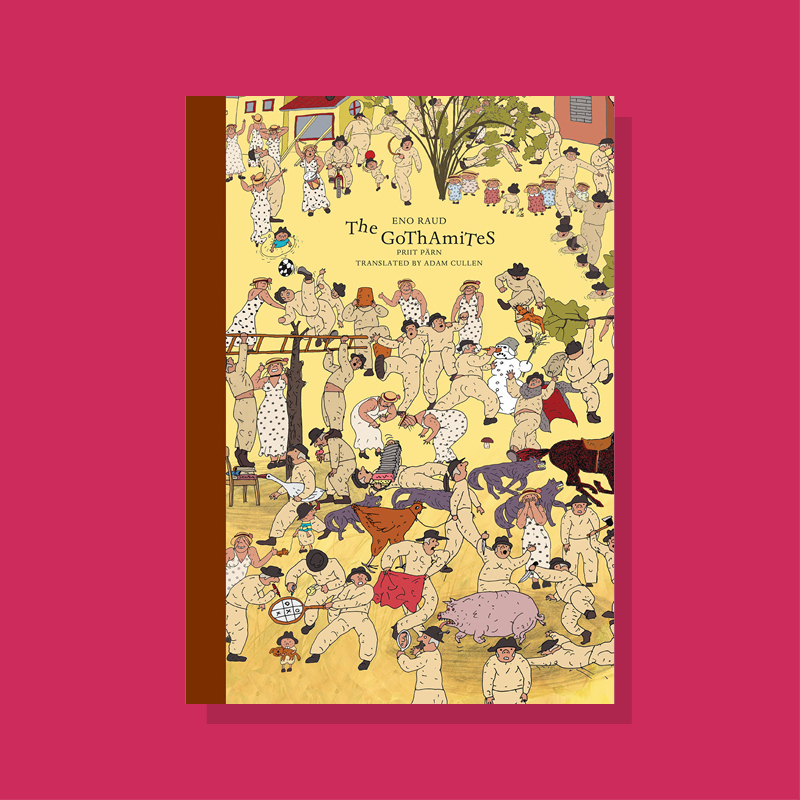
I don’t have any introductory platitudes for this book other than it was very, very strange and sent me down some rabbit holes. The little I know of Estonian literature is through its folktales and musical and lyrical prowess, and the design-centric environments complementing these Baltic childhoods.
Eno Raud was perhaps the best-known children’s author in Estonia, whose influential works and style impacted many other former Soviet countries. The Gothamites, from the Estonian Kilplased, is not only one of his earliest works but one of the first to be translated into English in 2019 by Archipelago Books’s children’s imprint Elsewhere Editions. Whereas Raggie and the four volumes of Three Jolly Fellows have various English editions, The Gothamites is the first and perhaps the only to have a dedicated publication team to ensure its quality, style, and marketability.
It is a story told in chapters about a society of individuals called the Gothamites who, once efficient, respectable, and wise, decided to vulgarize after returning from a diplomatic mission to see their community, left in the hands of apparently incapable women, left in tatters. Of course, during the introduction, one wanted so badly to grasp onto the redemption arc, looked for any intimation that perhaps the joke was on the men being impotent and this was all a ruse for matriarchy, but alas, it is important to keep in mind this was written in 1962 when, despite an ideology that prescribed equality of the sexes, men were still the majority in government. This radical social transformation is stupefying since the Gothamites originally were sought after for their expertise in so many matters in the first sentences of the text, only to devolve into further absurdities to maintain their existence.
I think early elementary school-aged children would very much enjoy the book, provided that younger ones are read to as the text can be long and challenging at times. Older children would appreciate some of the word play (“A whole dozen soldiers left the village in the morning…yet that night, no more than just twelve men returned”…from what we later understand was an attack by a rabbit). The visuals accompanying each vignette are also very enjoyable. Reminiscent of Where’s Waldo backgrounds and Bruegelesque genre paintings, the only exception is that while the former had us searching for a single icon amid the bustling environment, one can find the ubiquitous foolishness in every corner here. Sometimes slapstick, other times disturbingly illogical, it does well to compare legendary animator Priit Pärn’s illustrations to the stories that Raud had readapted from earlier European adaptations and traditions.
If you are an adult reading this, the anxieties of each invention and great idea, the motif of the head scratching decisionmakers, the ingenious imbecility slowly bring you to a realization that this isn’t so much an outlandish farce but perhaps a reality every generation seems to know. Maybe those that came before us didn’t so much plant salt seeds to grow more salt, carry hefty agricultural harvest on our backs and thinking we’ve spared the horse that now supports both the weights, or try to catch sunlight in sacks and containers to be released into the city hall that was built without much thought to ventilation, but those that govern never seem short on some sort of buffoonery. It’s funny when you are a kid because it is illogical, since this is the stage people develop pattern-identifying and problem-solving abilities. It is alarming when you are an adult, precisely too because it is illogical, since we take such pride in what we think are our refined sensibilities of social structures and norms. If you were living in Soviet Estonia at the time, I’m sure the incompetency of the apparatchiks is very clear in all of the nonsense happening in this book, so much so that it works extremely well as a critique of Soviet bureaucracy.
The specific rabbit hole that I fell into was the lineage of this story. Gothamite and the original Estonian word Kilplased were foreign to me and there isn’t that much in English to learn more about Raud’s work. Pärn, on the other hand, was instrumental in the rise of Estonian animation, and was influenced by the Rein Raamat 1974 animated short Kilplased that took further excerpts from this text. The English title may refer to “The Wise Men of Gotham” nursery rhyme from Mother Goose’s Melody in 1765:
“The wise men of Gotham,
They went to sea in a bowl,
And if the bowl had been stronger
My song would have been longer.”
Of course, this refers to the story that the people in Gotham, Nottinghamshire, feigned stupidity to avoid King John’s visit to their city to build a road to connect to his hunting lodge. It seems that there is a town like this everywhere, where both residents and foreigners alike scratch their heads as to how things could be so daft. Perhaps the greater concern is at what point do we lose touch and start to blur our actual mundanity with perceived ingenuity?
———-
My gratitude to Elsewhere Editions and Archipelago Books for sending me this book in a stack of fantastic children’s titles. They are such incredible supporters of world literature in translation for all ages and their books occupy a special shelf in my library.
— Sarah Wang, Programming Coordinator
